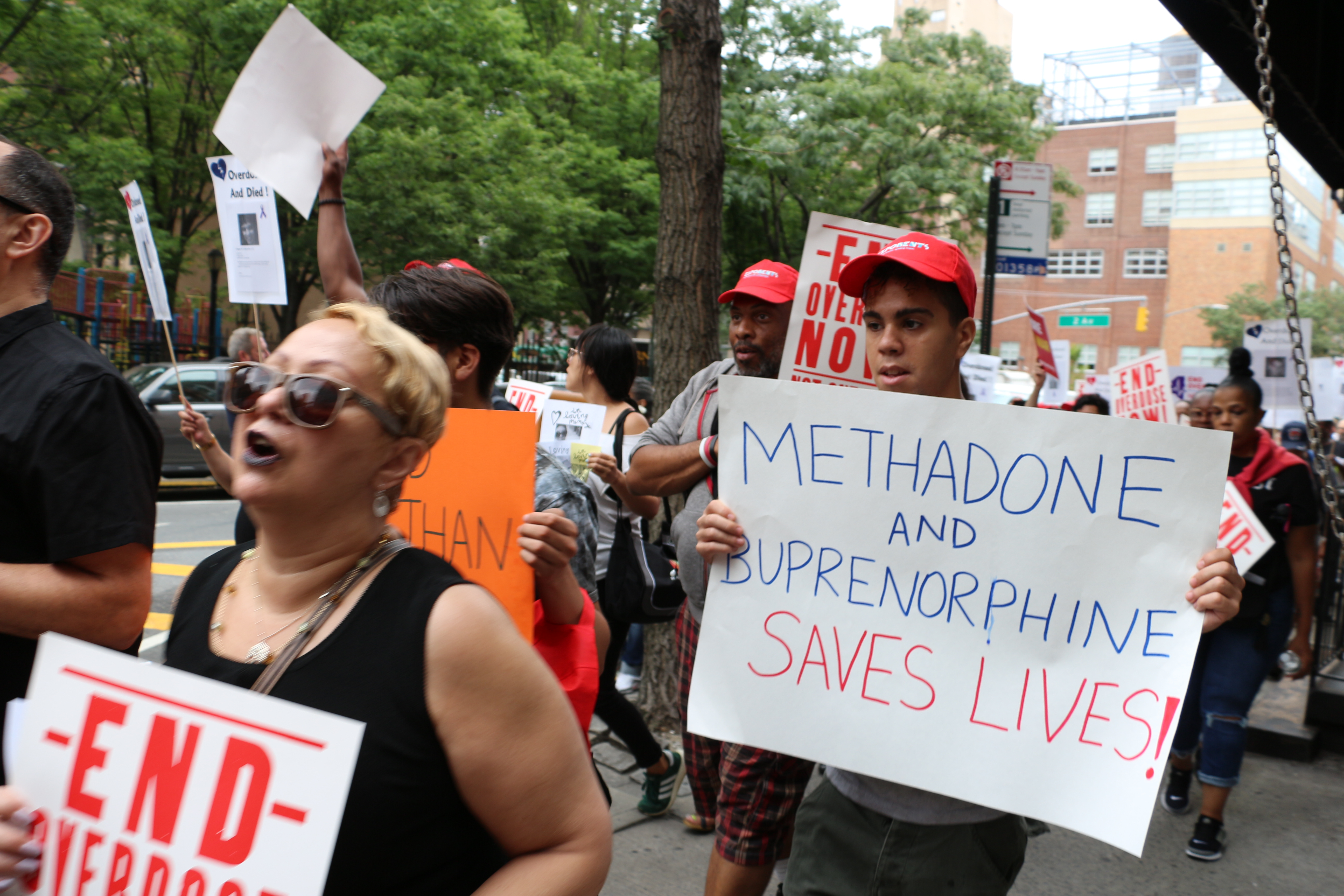Drug misuse, often called drug abuse, is the nonmedical use of a drug that interferes with a healthy and productive life. Drug misuse occurs at all economic levels of society, from the wealthy to the impoverished, and among young people as well as adults. Any drug may be misused, including alcohol, tobacco, medications, and substances that give off intoxicating fumes.
The misuse of drugs may lead to drug dependence, addiction, or both. Someone who becomes drug dependent experiences either or both of two conditions called tolerance and withdrawal. Tolerance and withdrawal are adaptations of the body to the effects of taking a drug over time. When a user develops tolerance to a drug, more of the drug is required to achieve the same effect. Withdrawal may occur when a user suddenly stops taking a drug. A major symptom of withdrawal can be craving, an intense desire for the drug. Depending on the drug involved, withdrawal symptoms may have serious medical consequences, including seizures and death.
Some people who misuse drugs develop an addiction, also called a substance use disorder. Substance use disorders are chronic brain illnesses. People with substance use disorders have enormous difficulty controlling their drug use. They may continue to use drugs despite adverse, sometimes catastrophic life consequences.
Experimentation with alcohol or other drugs often starts in adolescence. Young people may try drugs to explore their effects, to fit in with peers, or to try on adult roles and behaviors. Most people who try drugs do not become addicted. However, repeated use of alcohol, nicotine, or other drugs may lead to addiction.
Consequences of addiction may include poor motivation, impaired judgment and memory, personality changes, legal problems, and damage to careers and family relationships. Health problems may develop, such as AIDS, cancer, cirrhosis of the liver, and hepatitis. Drug overdoses may result in brain damage or death.
Drug use and misuse patterns vary throughout the world. This article chiefly discusses the problem in industrialized nations.
Misuse of legal drugs
Some of the most commonly misused drugs can be purchased legally by adults. They include (1) alcoholic beverages, (2) tobacco products, (3) over-the-counter drugs, (4) prescription drugs, (5) inhalants, and (6) steroids.
Alcohol
is one of the most commonly misused drugs in the world. Alcohol is a depressant that decreases the activity of the central nervous system. It also interferes with thinking, concentration, judgment, and coordination. Some people who repeatedly misuse alcohol develop alcohol use disorder. See Alcoholism.
Tobacco
is among the most addictive drugs. Repeated use can rapidly lead to addiction. The addictive element in tobacco products is nicotine. Nicotine is a stimulant, a chemical that excites the central nervous system. Trying to stop using nicotine-containing products causes withdrawal symptoms, including anxiety, feeling irritable, and craving the drug. This occurs, for example, when chronic smokers of cigarettes try to stop smoking them. Vaping nicotine products is also common. Vaping is the use of an electronic smoking device called a vaporizer. These devices allow users to inhale vaporized liquid. Vaping nicotine products is particularly common among adolescents and young adults. See Electronic cigarette; Smoking.
Over-the-counter drugs
that can be misused include cough and cold medications. Many of these medications contain such substances as alcohol or stimulants. Some herbal preparations that can be purchased legally at health food and grocery stores claim to increase alertness and energy. Athletes and other people may misuse these substances in an attempt to increase mental or physical performance.
Prescription drugs
can be obtained and used legally only when prescribed by a physician or other licensed prescriber. Many prescription medications have a high risk for misuse when taken in greater amounts than prescribed or when used by people for whom they are not prescribed. Commonly misused prescription drugs include amphetamines (stimulants), analgesics (pain relievers), and sedatives (tranquilizers). Adderall has become a commonly misused prescription drug among young people. Adderall is the brand name of a combination of the stimulant medications amphetamine and dextroamphetamine. It is often prescribed to treat students who have been diagnosed with attention-deficit/hyperactivity disorder (ADHD). For more information, see the articles Amphetamine, Analgesic, Barbiturate, and Tranquilizer.

Inhalants
give off fumes that are inhaled for their intoxicating, mind-altering effects. They include glues, nail polish, gasoline, and aerosol sprays. Inhalants take the place of oxygen in the lungs, depleting the amount of oxygen available to the brain. Inhalants can make the user feel relaxed, restless, uncoordinated, and sometimes delirious. Some fumes can cause lung, liver, and brain damage. They may also lead to heart failure, coma, and death, primarily due to oxygen depletion.
Steroids
are a type of prescription drug used medically for a variety of purposes. However, some athletes misuse anabolic (muscle-building) steroids to increase muscle size and strength. Misuse of steroids can cause aggressive behavior and serious mental disturbances, such as dramatic mood swings or psychosis. Steroid misuse can also lead to infertility, liver damage, and other serious medical problems.
Misuse of illegal drugs
In many countries, it is illegal to sell any drug, including alcohol and tobacco products, to children and adolescents. Many other drugs are illegal for both adults and minors—that is, under most circumstances, their possession and sale are forbidden by law. Illegal drugs include (1) marijuana (also called cannabis), (2) cocaine, (3) methamphetamine, (4) opioids, (5) hallucinogenic drugs, (6) dissociative drugs, (7) club drugs, such as Ecstasy, Rohypnol, and GHB, and (8) synthetic designer drugs.
Marijuana
is a drug made from the cannabis plant, which grows in most parts of the world. The main psychoactive (mind-altering) chemical in marijuana is tetrahydrocannabinol (THC). The dried flowering tops of the plant can be smoked in cigarettes or pipes. Marijuana products can also be eaten or made into an oil that can be vaped. Hashish, a thick, sticky resin of the plant, can be eaten or smoked.
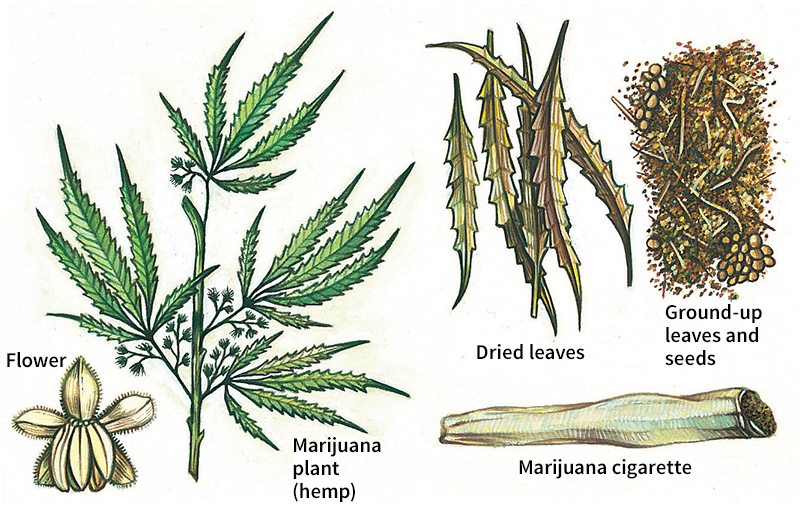
Researchers have found that THC can be addictive in some users. Regular marijuana users who attempt to stop may develop withdrawal symptoms. These symptoms include anxiety, decreased appetite, insomnia, and a depressed mood. Repeated, heavy use of marijuana impairs memory and learning. THC can cause distortions in perception, loss of coordination, increased heart rate, anxiety, and panic attacks. Respiratory consequences of smoking marijuana are similar to those caused by smoking cigarettes, including lung damage, chronic cough, and bronchitis.
Marijuana also contains a much less potent chemical called cannabidiol (CBD). Both THC and CBD have potentially beneficial medical uses, including pain relief and anti-inflammatory effects. THC and CBD are legally used for medical purposes in many parts of the United States and in some other countries. See Marijuana.
Cocaine
is a powerful stimulant made from the leaves of the coca plant, native to South America. Cocaine can be snorted through the nose, smoked in a form called crack cocaine, or injected intravenously. Smoking or injecting cocaine allows high concentrations of the drug to reach the brain, producing an intense, immediate euphoria (feeling of well-being) known as a “rush.” The drug is powerfully addictive when smoked or injected. Injecting cocaine increases the risk of acquiring HIV, the virus that causes AIDS.
The physical effects of cocaine include constricted blood vessels, dilated pupils, and increased body temperature, heart rate, and blood pressure. The “rush” rapidly wears off, and the person may then feel restless, irritable, and anxious. Cocaine users may develop paranoia, a delusion of persecution that can lead to aggression. Cocaine-related deaths may result from sudden stoppage of the heart, called cardiac arrest.
When addicted individuals stop using cocaine, they often experience depression and an intense craving for the drug. Thus, they have great difficulty stopping.

Methamphetamine
is an addictive drug that strongly stimulates the central nervous system. Methamphetamine has limited medical uses, primarily in the treatment of ADHD. Most misused methamphetamine is made in illegal makeshift laboratories. It is sold on the street under such names as “meth,” “crystal,” “ice,” and “crank.”
Methamphetamine can be taken orally, snorted through the nose, smoked, or injected. The drug causes the release of the chemical dopamine in the brain. Dopamine is a neurotransmitter (chemical that carries signals from one nerve cell to another). It stimulates brain cells, enhancing mood and energy. Repeated methamphetamine use, however, damages the brain cells that produce dopamine and other neurotransmitters, such as serotonin. This damage may eventually reduce the brain’s ability to produce dopamine and can result in mood problems and movement disorders.
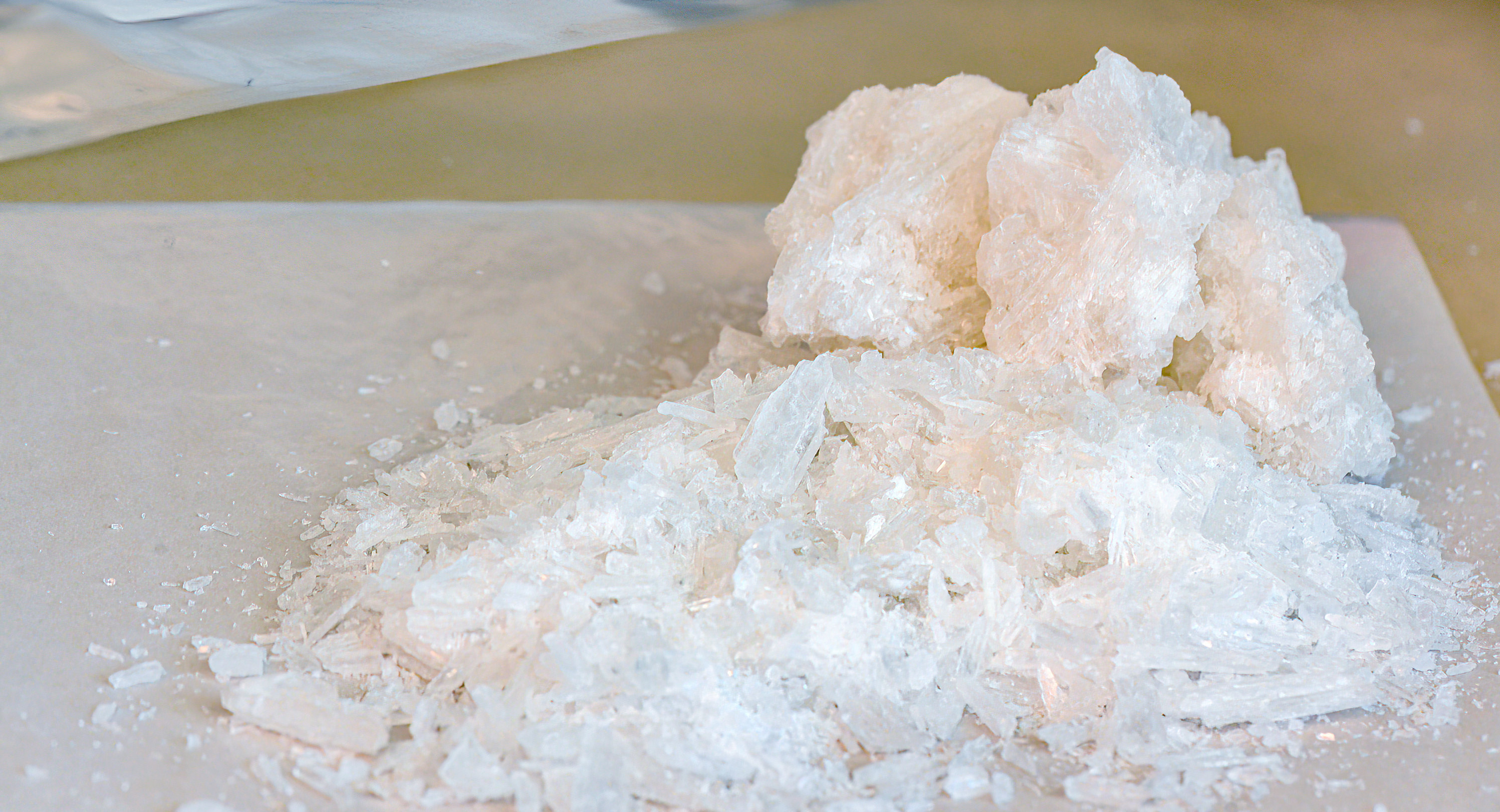
Smoking or injecting methamphetamine causes an intensely pleasurable sensation lasting only a few minutes. Users can become addicted quickly and use the drug more often at increasingly higher doses.
Methamphetamine increases alertness, physical activity, heart rate, and body temperature. It can also cause increased anxiety, confusion, tremors (shaking), seizures, insomnia, paranoia, and aggression. The drug can cause irreversible damage to blood vessels in the brain, leading to stroke. Use can also cause severe dental decay and tooth loss, known as “meth mouth.” Other effects of methamphetamine include decreased appetite with significant weight loss, an irregular heartbeat, heart attacks, and death.
Opioids
make up a group of drugs that include heroin and morphine. Heroin and morphine are derived from opium, which is the dried sap of the opium poppy. Physicians use morphine to relieve severe pain. Codeine is a less potent opioid used to relieve coughs and milder pain. Cough syrups with codeine can be addictive.
Most of the heroin sold illegally in the United States has been replaced by a powerful synthetic opioid called fentanyl. Fentanyl can be smoked, snorted, taken orally, or injected intravenously. Fentanyl is extremely potent. A two-milligram dose, equivalent in size to a few grains of sand, is potentially deadly. 

Opioids can be highly addictive. Users feel a surge of euphoria accompanied by a warm flushing of the skin, a dry mouth, and a sensation of heaviness in the extremities. Following the initial euphoria, mental functioning becomes clouded due to depression of the central nervous system.
Withdrawal from fentanyl can occur within hours after the last dose, causing drug craving, restlessness, muscle and bone pain, insomnia, diarrhea and vomiting, hot and cold sweats, and other unpleasant symptoms. These symptoms can lead a patient in withdrawal to relapse (begin taking the drug again). Opioid addiction can cause serious health conditions, including collapsed veins, infectious diseases such as AIDS and hepatitis, and fatal overdoses.
Opioid addiction can be effectively treated. Methadone and buprenorphine are medications that, when used as part of a carefully planned treatment, stabilize the patient, relieve the patient’s craving and withdrawal symptoms, and allow the patient to engage in a recovery program.
Kratom is a drug derived from a tree native to Southeast Asia. Its leaves have been used for centuries to relieve pain. The leaves can be brewed as tea or crushed into capsules or tablets, sometimes mixed with other ingredients. In low doses, kratom acts as a stimulant, but it has opioid effects in larger amounts. Users may develop a substance use disorder similar to opioid addiction. The U.S. government considers kratom to be a drug of concern because of its potential for misuse and addiction. The sale of kratom has been banned in several states.
Hallucinogenic drugs
include naturally occurring substances, such as mescaline, which is produced by the peyote cactus, as well as manufactured chemicals, such as LSD (lysergic acid diethylamide), which are made in laboratories. Hallucinogenic drugs affect the senses and emotions, commonly distorting perception of oneself and one’s surroundings. A few users may experience hallucinogen persisting perception disorder, in which the person has recurring episodes of distorted perceptions.

Dissociative drugs
include PCP (phencyclidine) and ketamine. These drugs produce a state of altered perception and a generalized “numbing” or dreamlike effect. Ketamine is also used as an anesthetic (drug that produces loss of feeling) in surgery. Dissociative drugs can have unpredictable effects in some users, including aggression, paranoia, delirium, seizures, or coma. Ketamine may be added as a liquid to marijuana or tobacco products, or used as a powder and snorted.
Dextromethorphan (DXM) is a medication found in some cough and cold medications. It is a cough suppressant at normal doses, but when taken in very high doses, it can have dissociative effects. Misuse of DXM, known as “robotripping,” is of particular concern with adolescents due to the availability of over-the-counter medications containing the drug. Persistent DXM users may develop addiction and withdrawal symptoms. Liver damage, coma, and death can result from the unintended consumption of high doses of other ingredients that are in these cold medications, such as acetaminophen.
Club drugs
are created in laboratories. They are known as club drugs because people often use them at nightclubs, at dance parties called raves, and at other social gatherings. Common club drugs include Ecstasy, Rohypnol, and GHB.
Ecstasy, also known as MDMA from its chemical name, 3,4 methylenedioxymethamphetamine, has hallucinogenic and stimulant properties. Other effects include nausea, blurred vision, grinding of the teeth, and increases in body temperature, heart rate, and blood pressure. Adverse effects in some users may include depression, insomnia, and anxiety, and may persist for weeks after taking the drug. MDMA and related chemicals have been found to cause brain damage in animals by destroying brain cells that regulate aggression, mood, sexual activity, sleep, and pain sensitivity. See Ecstasy.
Rohypnol, the common name for the drug flunitrazepam, is a sedative (relaxing) and hypnotic (sleep-inducing) drug that can produce unconsciousness and amnesia (loss of memory). The drug is taken orally in tablet form or dissolved in beverages. It is odorless and tasteless, and can be given to a person without their knowledge. Mixed with alcohol, it can incapacitate and prevent a victim from resisting physical or sexual assault. It can also prevent the victim from remembering what happened while under the influence of the drug. Rohypnol can produce withdrawal symptoms, tolerance, and addiction. 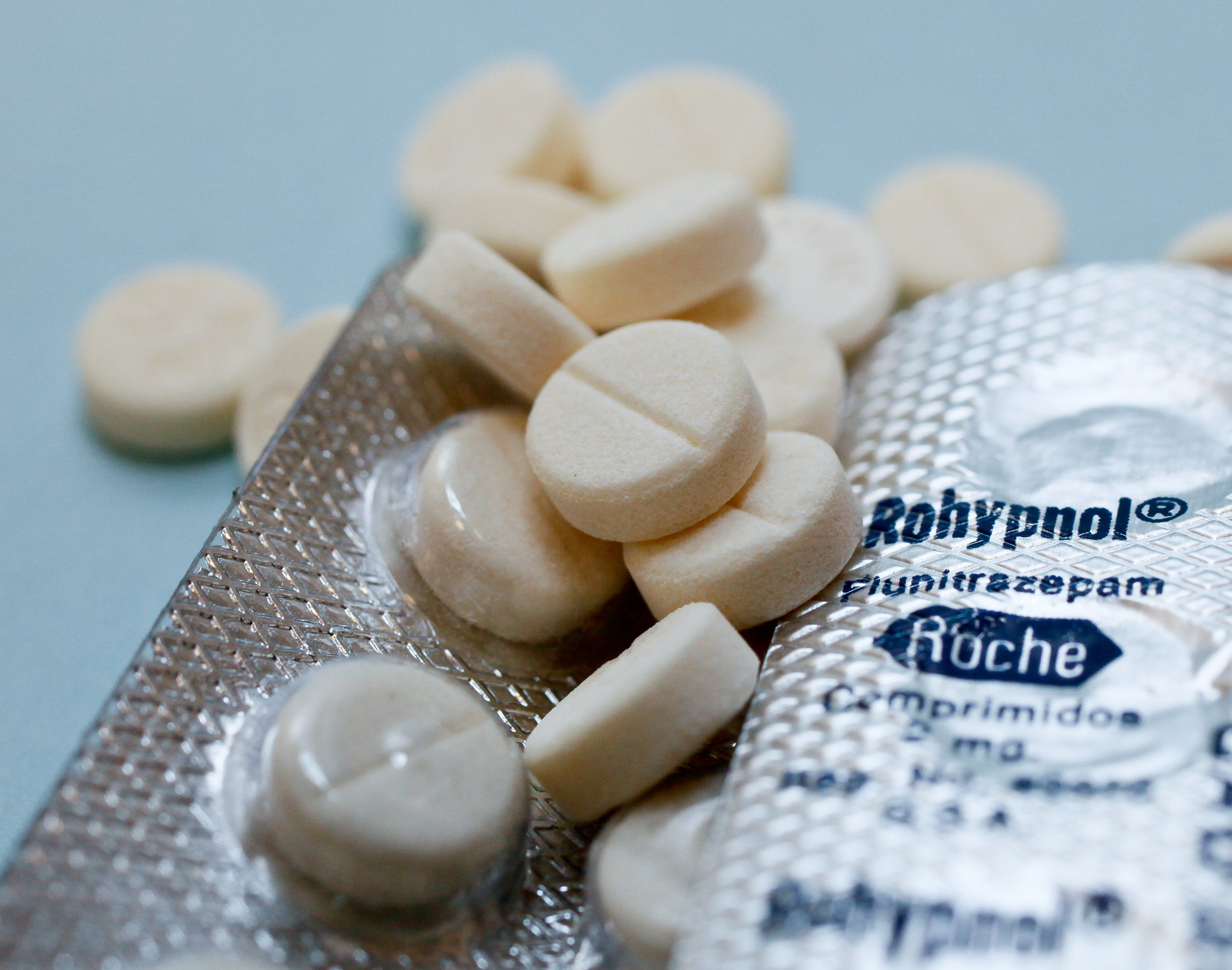
GHB is the common name for gamma hydroxybutyrate, a clear, odorless powder or liquid drug. It is misused for its euphoric, sedative, and anabolic effects. The purity and strength of individual doses can vary greatly, increasing the chance of overdose. GHB withdrawal may produce insomnia, anxiety, tremors, and sweating. GHB overdose can lead to loss of consciousness, seizures, coma, and death.
Designer drugs
are a diverse group of laboratory-created chemicals that include synthetic cannabinoids and “bath salts.” They may be sold in convenience stores and on the internet. The makers of these products may continually alter their chemical composition to evade legal restrictions. Users cannot know what chemicals or doses are present in a particular preparation, making their effects unpredictable.
Synthetic cannabinoids are chemicals related to THC. These chemicals may be sprayed on herbs, which may themselves have mind-altering properties. Synthetic cannabinoids may be sold as “K2” or “spice.” Effects may include agitation, paranoia, high blood pressure, a rapid heart rate, and kidney failure.
Bath salts is a term applied to a group of lab-produced designer drugs that have stimulant properties like those of methamphetamine. Taking bath salts can result in agitation, delirium, hallucinations, and seizures.
Causes and effects of addiction
Most adults with substance use disorders started using drugs as teenagers. Researchers have identified factors that are associated with an increased risk of developing a substance use disorder. Genetic factors play a role in increasing the risk of developing drug misuse and addiction. Toddlers and young children who are highly aggressive, or who have other behavior problems, may also be at higher risk of developing a substance use disorder.
The most important sign of addiction is compulsive drug use despite negative consequences. Addiction affects all areas of the person’s life, and it may result in neglect of family, friends, and work. Pregnant women who take drugs can cause harm to their unborn children. Drug users risk injury or death to themselves and others if they drive under the influence of a drug.
Drug users may resort to theft, prostitution, selling drugs, or other criminal activity to pay for their drugs. Injecting drugs contributes to the spread of infectious diseases, such as hepatitis and AIDS. Health professionals using drugs may make mistakes that endanger the patients under their care. Drug users in the transportation industry, such as bus drivers and air traffic controllers, risk endangering the public.
According to the U.S. National Institute on Drug Abuse (NIDA), the rates of drug misuse and addiction are higher in the United States than in any other industrialized nation. The federal government estimates that Americans spend several billion dollars on illegal drugs each year. However, the actual cost to society is much higher. NIDA and the National Institute on Alcohol Abuse and Alcoholism estimate the total economic cost of alcohol and drug misuse to be hundreds of billions of dollars each year. These costs include the price of hospitalization, property damage, time lost from work, and law enforcement efforts.
Treatment of substance use disorders
Drug misuse and addiction often disrupt many parts of a person’s life. Effective treatment must address all these areas and teach the skills the person needs to maintain a drug-free lifestyle. Because a person’s addiction typically affects their family relationships, experts strongly recommend including family members in treatment planning.
Some people require medically supervised detoxification as the initial phase of their treatment. Detoxification is used to manage withdrawal symptoms. In detoxification, medications are given to control these symptoms. Over days to weeks, the patient takes gradually less medication until it is no longer needed.
Once the patient is stabilized, treatment may include both medication and psychological treatment. Medication treatment generally works by (1) blocking the chemical mechanisms of drugs that reinforce compulsive-use patterns, or (2) stabilizing disrupted brain pathways that are involved in drug craving, withdrawal, and relapse. Physicians may also prescribe medications to treat common co-occurring disorders, such as depression, that drug users often experience with addiction.
Psychological treatment includes various forms of counseling. Behavioral therapy and family therapy focus on helping people with addictions by teaching them to change unhealthy habits, behavior, thinking, and family patterns. Many people with addictions are helped by joining such groups as Alcoholics Anonymous (AA) or Narcotics Anonymous (NA). Members of these groups come together to share their experiences and support each other in remaining drug- and alcohol-free. 
People with addictions may relapse (begin taking drugs again). Relapsing after treatment does not mean that drug treatment is ineffective. Researchers have found that substance use disorders are chronic brain illnesses, similar in many ways to other chronic medical and psychiatric diseases, such as diabetes or depression. Long-term, scientifically based treatments for addiction can be as effective as treatments for many other chronic illnesses.
Combating drug misuse
To combat drug misuse, public health experts work to increase awareness of the consequences of drug use. They also stress the importance of easy access to treatment for substance use disorders. Government agencies enforce laws banning the sale and transport of drugs.
Reducing supply.
The United States is the world’s largest, most profitable illegal drug market. Large profits attract drug suppliers from many parts of the world. To discourage drug smuggling and dealing, known as drug trafficking, U.S. laws provide for severe punishment for anyone convicted of those crimes. Drug traffickers can receive a minimum sentence of 5 to 10 years in prison. They can receive the death sentence if a death results from their drug activity. The Drug Enforcement Administration (DEA), a part of the U.S. Department of Justice, combats drug trafficking within the United States and abroad. It works with federal agencies and other governments to arrest those who produce, process, distribute, and finance illegal drugs.
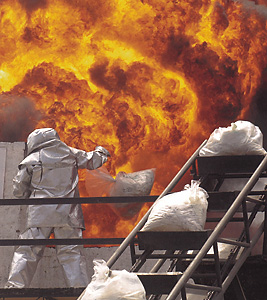
Reducing demand.
Schools and communities play an important role in preventing drug misuse. Effective school prevention programs include accurate, age-appropriate information for students about the risks of drugs, as well as training in how to solve problems and enhance communication.

Communities help prevent drug misuse by enforcing laws that prevent the sale of tobacco, alcohol, and other drugs to children and adolescents. Prevention and early treatment efforts focus on addressing behavioral, family, and school problems. Community programs that create healthy and productive recreational outlets for adolescents have successfully reduced drug misuse.
The United States has several laws to discourage and reduce the risk of drug misuse. The Comprehensive Drug Abuse Prevention and Control Act of 1970 lists the most addictive and dangerous drugs. It also strictly regulates the manufacture, sale, possession, and use of drugs.
To discourage drug misuse among employees, some companies test workers for the presence of drugs in their urine, blood, or hair. Many employers require job applicants to pass a drug test. Other companies have random testing for airline pilots, railroad operators, and others involved in public safety. The United States began testing military personnel for drug use in 1981.
The legalization debate.
Drug misuse and addiction persist in the United States despite billions of dollars spent each year trying to eliminate them. Because efforts to reduce drug misuse and drug-related crime have not been as effective as hoped, some people have suggested that drugs be legalized.
Supporters of legalization believe laws against making and selling drugs should be overturned. They argue that if drugs were legally available, illegal drug dealers would go out of business and drug-related crime would be reduced. The billions of dollars spent on law enforcement could then be devoted to drug education and treatment programs. Since 2012, several U.S. states have legalized the medical and recreational use of marijuana.
Others suggest changing laws so that possession of drugs in small amounts would not be a criminal offense. Such changes, called decriminalization, would make personal use of drugs legal or subject only to a small fine. Efforts to arrest drug traffickers, however, would continue.
Opponents of legalization fear that making drugs legally available will encourage the use of dangerous substances. They argue that when substances such as alcohol and tobacco have been legalized and become more available, they have become more widely used and misused. The widespread misuse of these drugs has created numerous public health problems and costs to society. Legalized drugs would be more available to everyone, including those most at risk for developing addictions. The number of people who would develop problems associated with drug misuse and addiction would also increase.
History
Drugs have been used for thousands of years in their natural plant form. In the 1800’s, scientists learned how to isolate (chemically separate) drugs from plants. Such advances in chemistry made morphine, cocaine, and heroin available for the first time. Initially, doctors welcomed these powerful drugs as helpful pain relievers. Gradually, people realized how easily these drugs could become dangerously habit-forming.
In the late 1800’s, most countries had no national laws controlling drugs. People could buy opium and morphine whenever they wanted. Many medicine companies hid the fact that their remedies contained addictive substances. As a result, by the early 1900’s, many countries faced an epidemic of drug addiction.
In the United States, the first federal law to help protect the safety of people using drugs was the Pure Food and Drug Act of 1906. This act required labeling of the amount of certain substances, including alcohol, opioids, cocaine, and marijuana, in nonprescription medications. However, people could still purchase these potentially dangerous medications legally.
Public and political pressure for national controls over narcotic and cocaine sales led to the Harrison Narcotic Tax Act of 1914. This law and subsequent modifications made opioids and cocaine available only by prescription by a physician.
In 1937, Congress passed the Marihuana Tax Act, banning the nonmedical or untaxed possession of marijuana. By the early 1940’s, medical use of this drug was minimal.
In the 1950’s, use of amphetamines, sedatives, and marijuana increased. In the 1960’s and the 1970’s, drug use soared. Marijuana, LSD, and other drugs gained broad social acceptance. Many young people tried drugs in a search for spiritual insight, as a rejection of adult values, or simply for pleasure.
As a response to increased drug use, the United States government began a “war on drugs” to combat drug misuse. The war on drugs sought to reduce the illegal drug trade by requiring prison sentences for drug possession. As part of this effort, the government created the Drug Enforcement Administration (DEA) in 1973.
Since the 1980’s, law enforcement has been tasked with making more arrests for drug possession and sales. Nonviolent drug offenders have crowded courtrooms, jails, and prisons, creating a burden on the criminal justice system. The proportion of African American men in prison has drastically increased. Social scientists credit this increase to racial bias in antidrug policies.
In the 1990’s, an opioid use epidemic started in the United States after pharmaceutical companies began to heavily promote the use of prescription opioids. The number of opioid prescriptions in the United States tripled between 1991 and 2011. Opioid overdoses and deaths significantly increased. 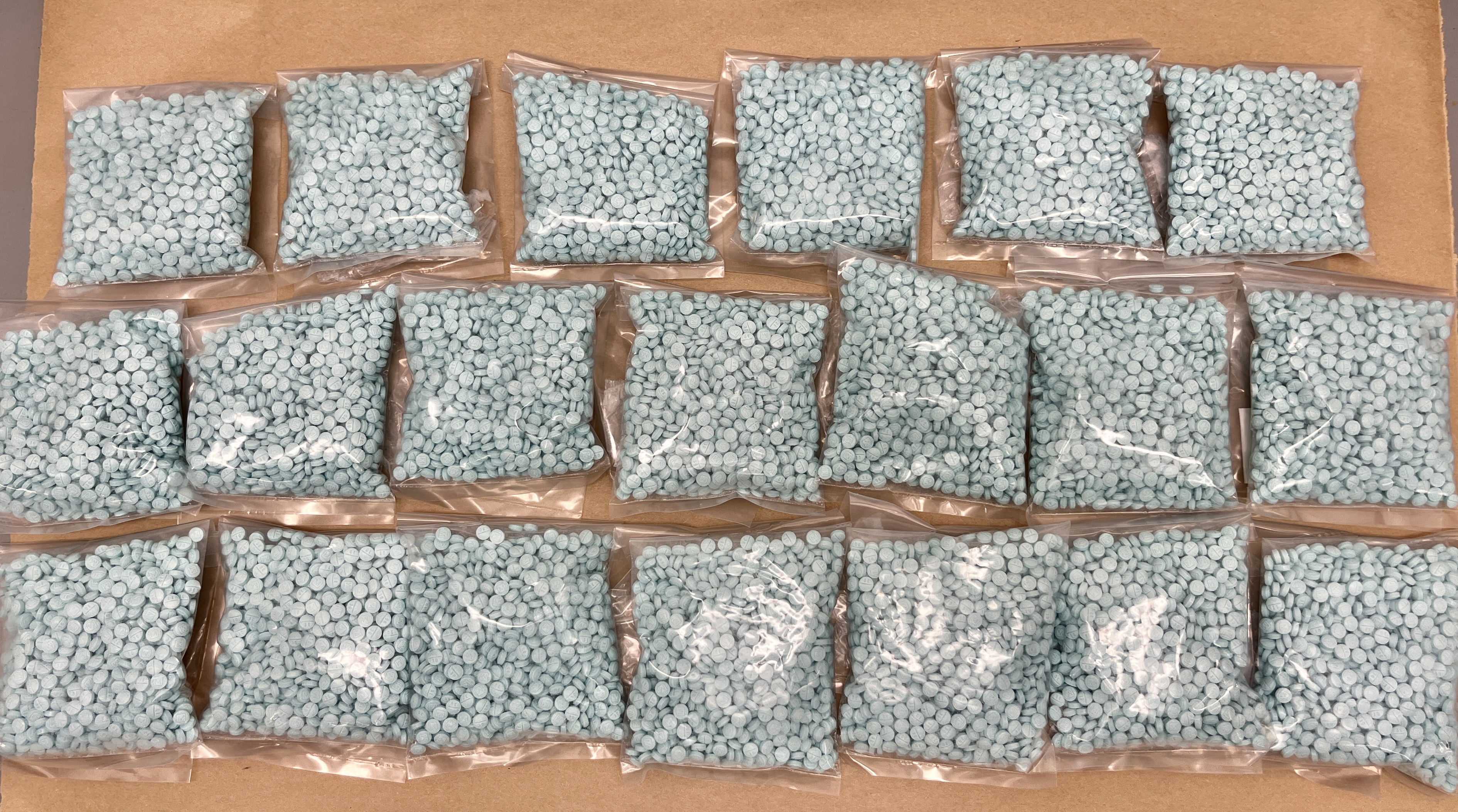
By the early 2010’s, the epidemic had become more widely known. Doctors prescribed fewer opioids. People addicted to opioids could not obtain them as easily. They began using heroin instead. However, by the late 2010’s, more overdose deaths were caused by fentanyl and other synthetic opioids than by heroin. Synthetic opioid overdose deaths increased each year after 2013. The number of deaths increased particularly sharply from 2019 to 2020, the first year of the COVID-19 pandemic (see COVID-19 (The COVID-19 pandemic)). By 2022, the United States had more than 100,000 overdose deaths per year.
Scientific research on drug misuse and addiction and the effects of drugs and alcohol has increased dramatically. NIDA funds most of the world’s research on the causes, biological effects, prevention, and treatment of substance use disorders. NIDA’s website at nida.nih.gov provides accurate information on a wide range of topics related to drug misuse. 